Meet Susan Erikson Hawkins | artist/sculptor

We had the good fortune of connecting with Susan Erikson Hawkins and we’ve shared our conversation below.
Hi Susan Erikson, how do you think about risk?
I think risk taking is very important. In a way, my entire career path can be seen as a series of absurd risks combined with blind leaps of faith. Each time I’ve taken a chance, or risk, it has changed the course of my life and career for the better, each leading to a more interesting, more unique, and more challenging opportunity.
I took a big risk just deciding to get an art degree. At that time, the common response to that was, “How are you going to support yourself?” I decided to pursue it anyway because I figured that I had a better chance of being successful at something that I was really interested in as opposed to just getting a degree in something practical that I didn’t really care about.
After struggling to find my way during my first year of college, and trying out several majors that didn’t fit, I did some serious soul searching about what I really wanted to do. As a child, I really enjoyed drawing, but it got pushed aside by academics and other pursuits such as dance and music. However, it was something that I had always been told I was good at, so I thought that an art degree might be a possibility.
On the recommendation of a college counselor, I went to visit CSULB in the middle of the summer heat. When I got there I found green grass, beautiful flowering trees and a lovely ocean breeze. I don’t think I even found the art department but I immediately decided I would go there. When I started classes, I thought that I might go into graphic design, because, of course, you can get a job. However, once I started, I found I really loved my life drawing classes. So I took the chance and switched my major to drawing and painting, not really knowing what I was going to do with it. I am so glad I took that chance and followed my intuition. It led me to where I am today.
I got started as a sculptor sort of by accident. I was nearly finished with my degree, when I discovered that I was required to take beginning life sculpture to graduate. From my first day in class, I knew that I had finally found my true direction. This was a hard realization. After taking so long to finish my BFA, I knew that I was going to have to stay in school to pursue another degree in sculpture. So, with the jibes and jeers of my ever-loving family and friends ringing in my ears, “Are you ever going to finish school?”, I applied for the MFA program in sculpture. At least now, I could tell them that with an MFA, I could truly get a job teaching art on the college level. When I was given the opportunity as a graduate student to teach beginning life sculpture, I took that chance, having absolutely no idea of how to teach. I floundered about for a bit, but surprisingly, I really liked it. When I finally graduated, I had two solid years of teaching experience already on my resume which led to my first real job out of college- teaching sculpture at the Academy of Art College in San Francisco.
When it comes to making art, you have to be willing to experiment, which by definition, means taking a risk- to try something knowing that it might fail. You have to push yourself beyond what you know you can do. You’re going to fall down a few times until you get it right, but otherwise, you’ll just keep making the same artwork over and over.
For a few years, I had a studio at Angels Gate Cultural Center in San Pedro. I was asked to participate in an exhibit at the art gallery there showcasing the work of artists who had worked in the studios in the past and those who were currently working in them. I had a lengthy conversation with the curator about what kind of work he wanted for the show. Clearly, he was not looking for classical figure studies. I thought I had a pretty good idea about what he wanted. Then, when I started getting ready to make the sculptures, I realized I really had no idea what he wanted. However, I’d already agreed to participate, so I started experimenting with re-making old steel armatures and combining them with direct plaster and wire mesh. I don’t think I slept for three months, but in the end, I had a set of very experimental open-form, mixed-media, plaster sculptures that were distinctly different from the classical figure studies I had been making. It was really challenging to break away from my usual pattern but it changed the direction of my work entirely, making me receptive to many different options that had never seemed possible previously. I was so nervous when I delivered the sculptures to the gallery. I asked the curator if they were what he was expecting. He looked at me sideways and said, “No, but I think they’re really cool.” We had a good laugh over that.
Not long after this, out of the blue, I was offered the job to work on “Play-Doh”, by Jeff Koons. Strangely, they were looking specifically for someone who did figurative sculpture and used direct plaster in their own work, which is what I had been doing. So I drove fifty miles out to San Fernando to interview for the job not really having any clear idea of what they wanted. When I got there, I found this huge incredible facility dedicated to the making of large scale art. They had almost every possible tool you could ever need, and a huge crew of really skilled fabricators who could do almost anything- metal working, wood working, machining, painting.. etc.
They took a risk too, in hiring me, a relatively unknown artist, to work on a very large, experimental sculpture for a very high-profile client. Working on “Play-Doh” was one of the craziest and most challenging times in my life, but it proved to be one of the most rewarding. It afforded me the opportunity again, to really push beyond my boundaries on many levels- from developing new creative and technical skills, to working with a team, and eventually, to managing a team. All of this directly impacted my next adventure- my first large sculpture commission.
In 2015, I was invited to submit a proposal for a large outdoor work of art for a new construction project in the East Village area of Long Beach. I had never actually put together a proposal of this scope before, or actually designed a sculpture on that scale. I had no experience with budgeting, engineering, or scheduling. I was truly surprised to win the commission for a large, forged stainless-steel wall sculpture. I was fortunate to have had the “Play-Doh” experience so at least I had an idea of how it could work. I also now had contacts to draw on.
I was able to pull together a team of advisors: project managers, digital technicians, and engineers, to guide me through the R & D process, create the 3-D images and technical construction drawings as well as finalize the design for ease of fabrication, structural stability and compliance with building codes. Then there were the metal fabricators and finishers who actually built, finished, and installed the sculpture. It was a wild, rocky ride but my sculpture, ”Revolve” was finally completed and installed in 2020.
Life, the Universe, Fate, or whatever you want to call it, presents choices and forks in the road from time to time. You can choose the safe, secure option, or you can choose the unknown path, the one whose outcome is unsure but which might present unlimited possibilities. With every project I start, there’s always that fear, that question in the back of my mind- can I do this? Will I be able to deliver? But each time I’ve leapt off the deep end and taken that risk, I have been so thankful that I did.
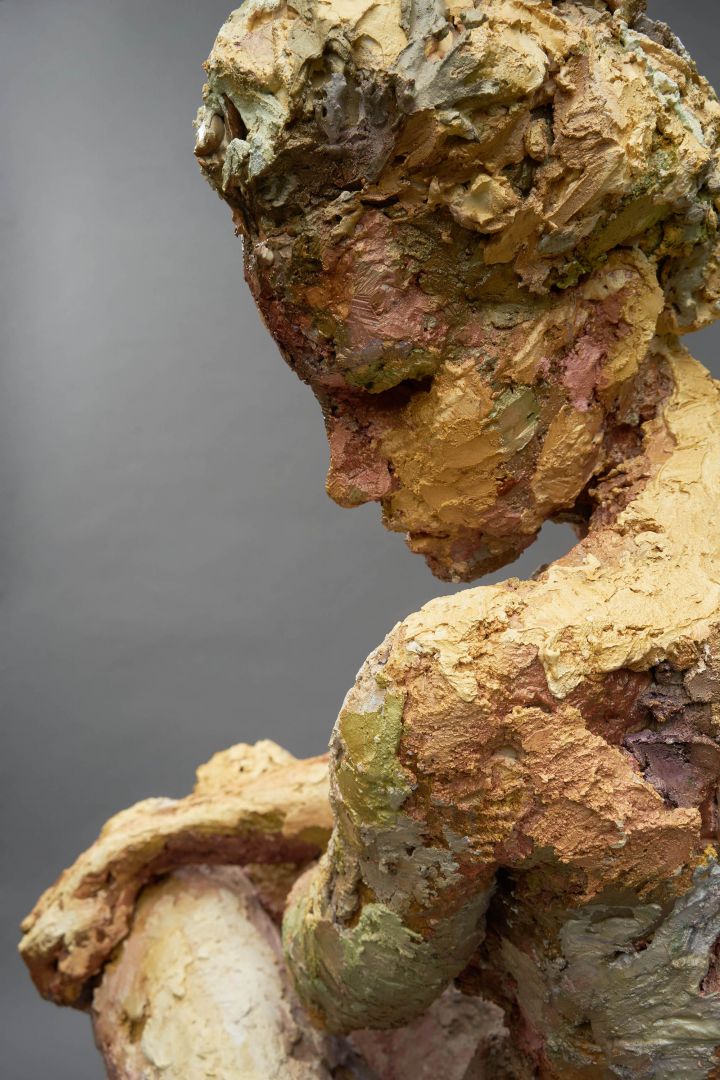
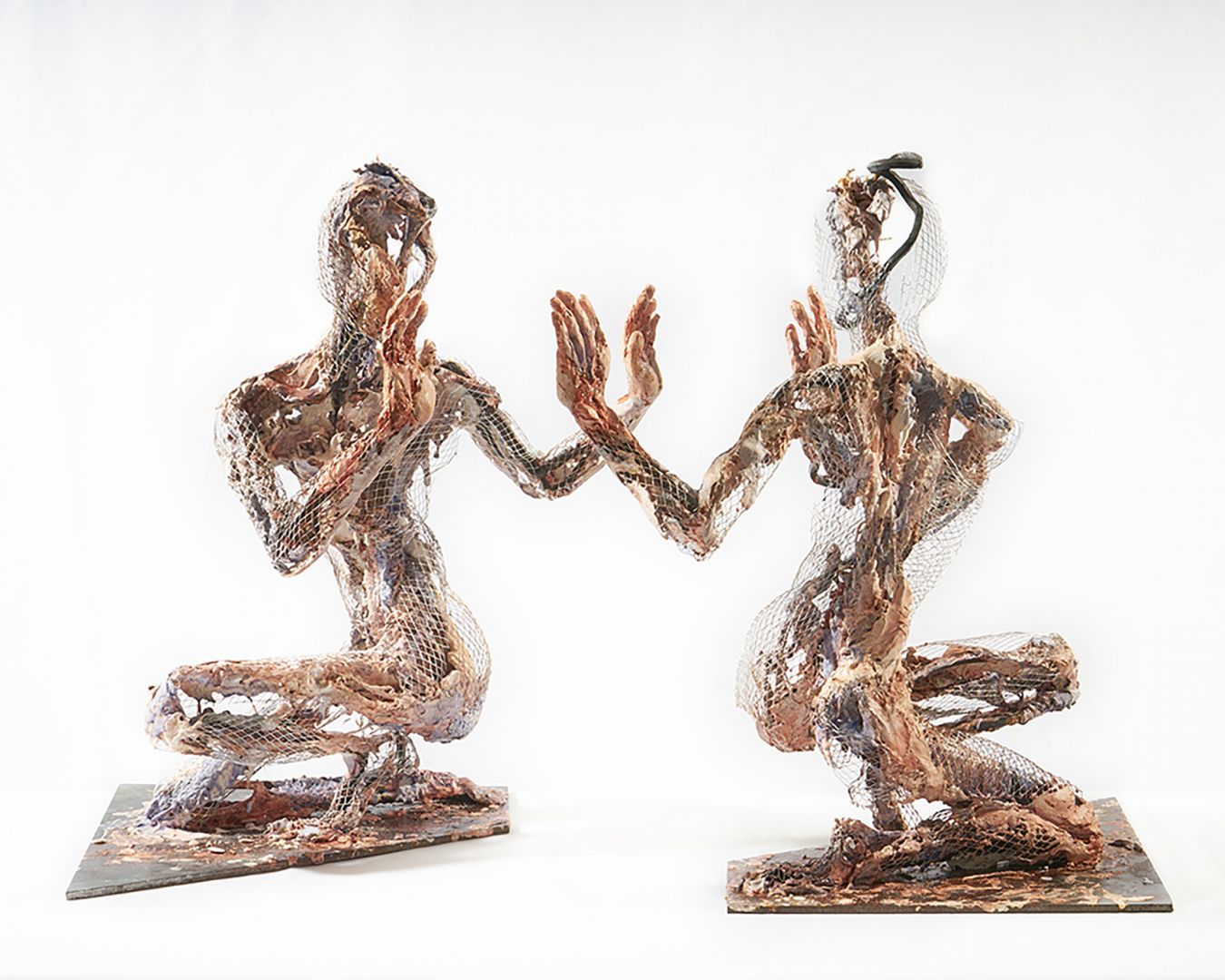
Let’s talk shop? Tell us more about your career, what can you share with our community?
I am a figurative sculptor. All my work depicts the human body or refers to it. I work from direct observation of life, by working with live models. My early work was more realistic: traditional figure studies in clay, plaster and bronze. The newer pieces are more expressionistic: mixed-media open forms, but always recognizable as coming from the human body. My fascination with the human form stems from my early days as a dancer. I love the way the body moves- the lines, the shapes it makes as it moves in space, its strength, as well as its fragility, but especially, its energy. This dynamic is what I strive to express in my work.
Working with clay came very naturally to me. I fell in love with clay from the first moment I had my hands in it. It has a density and flexibility that is not unlike the human body. It is almost like a living thing. I found I could work with it quickly- moving it easily to convey form and gesture spontaneously, much like doing quick gesture drawings with charcoal on paper. On the other hand, I could work the clay to a level of finish and surface detail that belies the nature of the spontaneous material, disguising the fact that it really is just an over-the-top mud pie.
I try to let the medium I’m working with guide the direction of the work. The textures of the material and traces of the process used to shape it are always left to be seen as part of the finished work. For example, a sculpture made originally in clay and then cast from a mold into plaster can have a very different look from one that was made directly in plaster.
A unique feature of my work is my use of color. Coming from a drawing and painting background, I was looking for a way to add color to my work, to break up the monochromatic look of the traditional sculptural mediums that I was using. I experimented with painting them, but I was looking for something that could be worked intrinsically into the nature of the sculpture rather than just functioning as a coating sitting on top of the surface. When I started mixing color into the plaster, the color became a kind of light source. The sculptures evolved into 3-dimensional paintings.
In addition to making and showing my own work, I have worked as a studio assistant for other artists. It was my work in direct plaster that brought me the opportunity of a lifetime that really changed the course of my career. I was given the opportunity to work on the sculpture, “Play-Doh”, by Jeff Koons at the renowned art fabricators, Carlson and Co., and later at Hand Made, now one of the preeminent art fabricators in Southern California. Working on Play-Doh was an amazing education. Not only was I part of a team working on a huge, complex artwork for one of the most famous living artists in the world, I also got to see many other large-scale artworks by other major artists being built.
I also had to learn to push my sculpture skills to the next level. I had to learn how to listen and interpret someone else’s ideas and translate them into form. The artist’s vision evolved rapidly as the work progressed. He always wanted something different. At one point, after a particularly devastating critique, I told them that they should fire me because clearly, they were not happy with any of the work I did. They looked at me with surprise and said, “We love what you’re doing.” I was shocked. It made me take a step back and re-evaluate my position there. It changed my approach to the work and taught me to not take the criticism so personally even though that was difficult to do. It was incredibly challenging and frequently agonizing, but the end result was amazing. I am eternally grateful for the help and support of the other more experienced sculptors on the “Play-Doh” team who took me under their wings, and shared their knowledge and experiences with me.
Recently I saw my first large commission, “Revolve”, a large, hand-forged, stainless steel wall sculpture for The Alamitos building in Long Beach, CA, installed in 2020 during Covid. The sculpture depicts three views of an abstracted female torso in rotation. It was five years in production to make and was my first experience in managing the fabrication of one of my own sculptures. It was a huge, terrifying leap from making small sculptures on my own to making a large sculpture for the public arena in a material that I had not actually worked with or even had the tools to work with before. There were many long anxious days and sleepless nights during the process, but my years of working on “Play-Doh” had taught me the value of teamwork- that anything was possible when you can find the right people to help you.
After spending many years working on artwork for other artists, it’s so exciting to finally share one of my own creations with my community. Like many people, Covid gave me a lot of time to think and re-evaluate my life and work. I am looking forward to experimenting with other forms & materials in a new series of sculptures.

Let’s say your best friend was visiting the area and you wanted to show them the best time ever. Where would you take them? Give us a little itinerary – say it was a week long trip, where would you eat, drink, visit, hang out, etc.
I’d start with Steelhead Coffee or The Merchant Coffee House & Bakery in Bixby Knolls followed by shopping & lunch in Bixby Knolls along Atlantic Ave. Then, I’d be sure to drop in at the Expo Gallery and check out the artwork in the Allery- the outdoor gallery/mural space in the alley at Burlinghall Dr. off Atlantic between EJ ‘s Pub and Red Wing shoes. Then, I’d drive up to Hilltop Park on top of Signal Hill for the 360 degree views. Then drive to the East Village Arts District & downtown Long Beach. I’d take a drive over the new bridge, The Long Beach International Gateway, towards San Pedro to see the views of the Port. Then up to Angelsgate Cultural Center Korean Friendship Bell for the views From Point Fermin towards Palos Verdes. Then back over the bridge for more views of the port. Another day, I’d go to MOLAA (Museum of Latin American Art) and go for vintage shopping and lunch on 4th street’s Retro Row. Or I’d visit the Long Beach Museum of Art & have lunch at Claire’s Restaurant on the Bluffs overlooking the ocean, then check out the current exhibit at the Long Beach Creative Group’s Rodd Briggs Gallery on Broadway . I’d also check out the current exhibit at Loiter Galleries on the Promenade in DTLB and go to see all the Pow-Wow murals throughout the city.
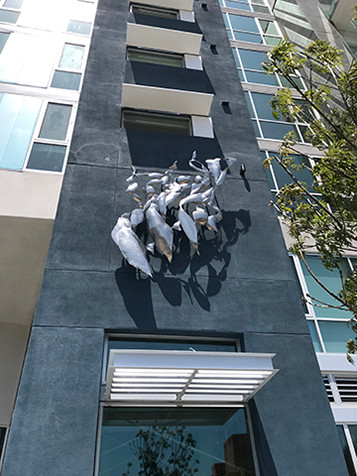
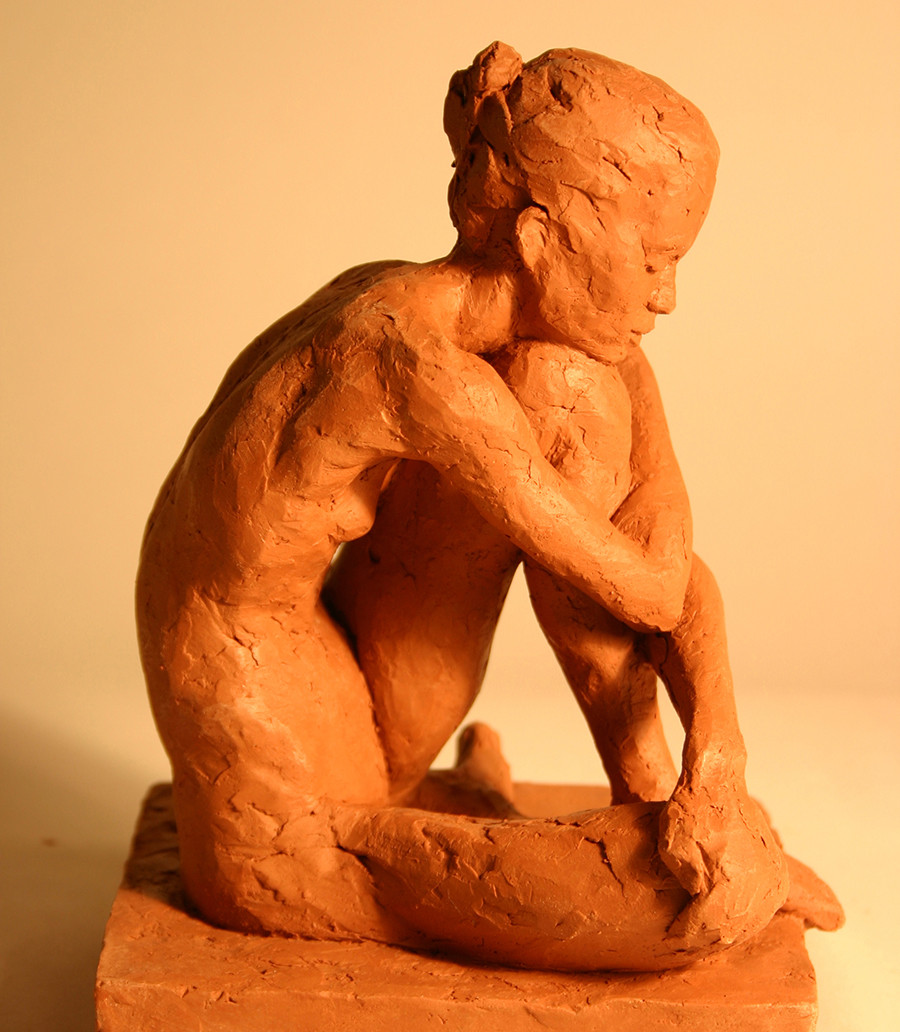
Who else deserves some credit and recognition?
I must give some credit to my parents, who, after asking that initial question of “how are you going to get a job,” and despite questioning many of my other decisions, never questioned that my decision to go into art was the right one. My husband, Bernie, has been my most constant supporter since we first met in college, helping with everything from stretching canvases to building armatures and sculpture bases, and providing engineering advice. My very good friend, Thor Carlson, of Gallery Thor, who has been showing and promoting my work since 2005, likewise, is always there to help as curator, studio assistant, photographer, open studio tour sales manager, and even art model.
I must also give credit to the many amazing teachers that I had over the years but in particular, my sculpture teacher, Steve Werlick, who was head of the sculpture department at CSULB. He took such joy in life and making art and passed that on to his students. He taught me to sculpt, but also to trust in my artistic abilities. He took a big chance on a very green sculpture student and gave me my first teaching job as a graduate student at CSULB, dispelling any doubts that I could actually get a job with an art degree.
My time spent in the studio at Angels Gate Cultural Center was magical and made more so by the other artists and friends working there. I am especially thankful for the assistance of the artists, Rique Guzman- my then studio assistant, and Kajsa Sjodin, model and amazing chef.
I am eternally grateful for the help and support of the other more experienced sculptors on the “Play-Doh” team at both Carlson and Co., and Handmade- Kirk Starbird, Jarred Pojawa, Karl West, Waylon Dobson, Norman Franklin Lloyd, Martin Bottjer, who took me under their wings, shared their knowledge and experiences with me, and showed me how to keep my sanity by finding the humor in everything.
And of course, I extend my bottomless thanks to the people who made my sculpture “Revolve” possible: Sumako Sozdatel for inviting me to apply for the “The Alamitos sculpture” commission and who oversaw and guided me thru that process, Mark Rossi of Handmade for general advice and budgeting information, Norman Franklin Lloyd for research and development, project managing, replicating my original prototype in 3-D and generating the construction drawings;, Doug Loesch and Kevin Kelly, engineers, Paul Bosserman of Old Anvil Speedshop who built and installed the sculpture, Dave Anzures, Jr. of Cal Tech Plating for educating me on metal finishing processes, and Alan Olnick of General Bright Metal Plating who did the final surface finishing.
I also have to give credit to the many fellow students, family members, & friends who are/were always available to lend a hand, give encouragement, be sounding board, or a shoulder to cry on.
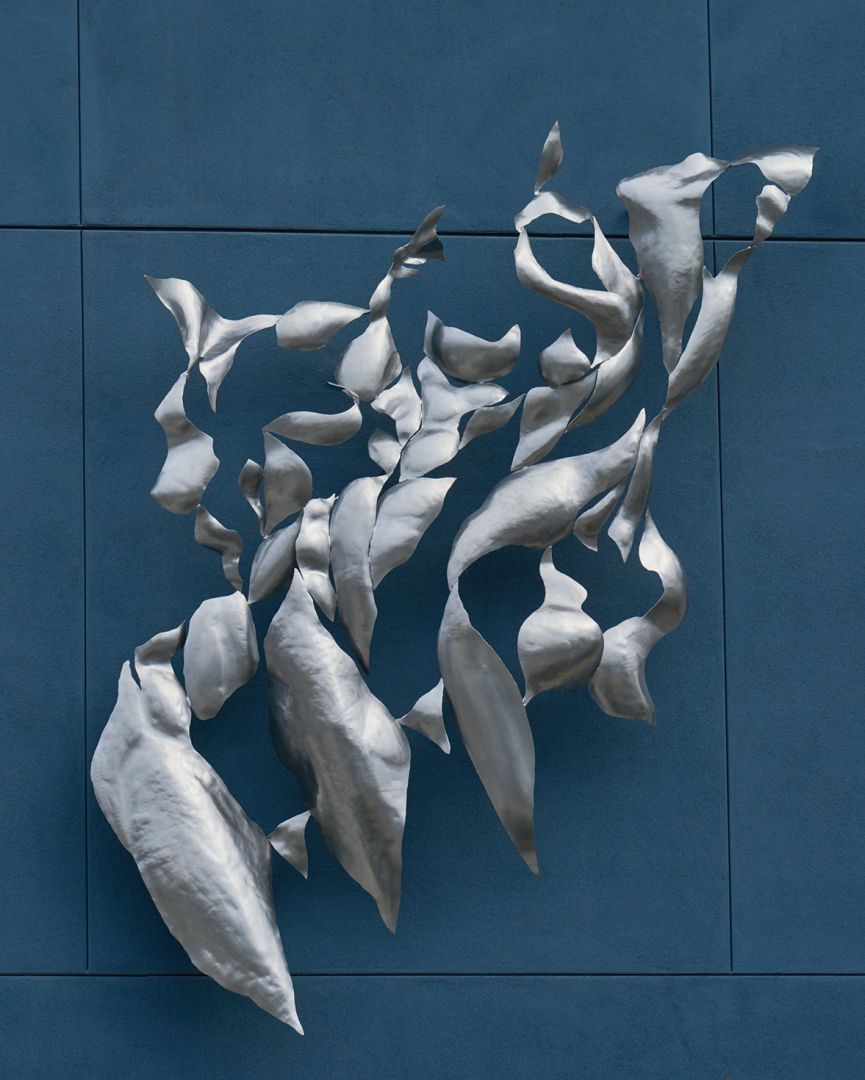
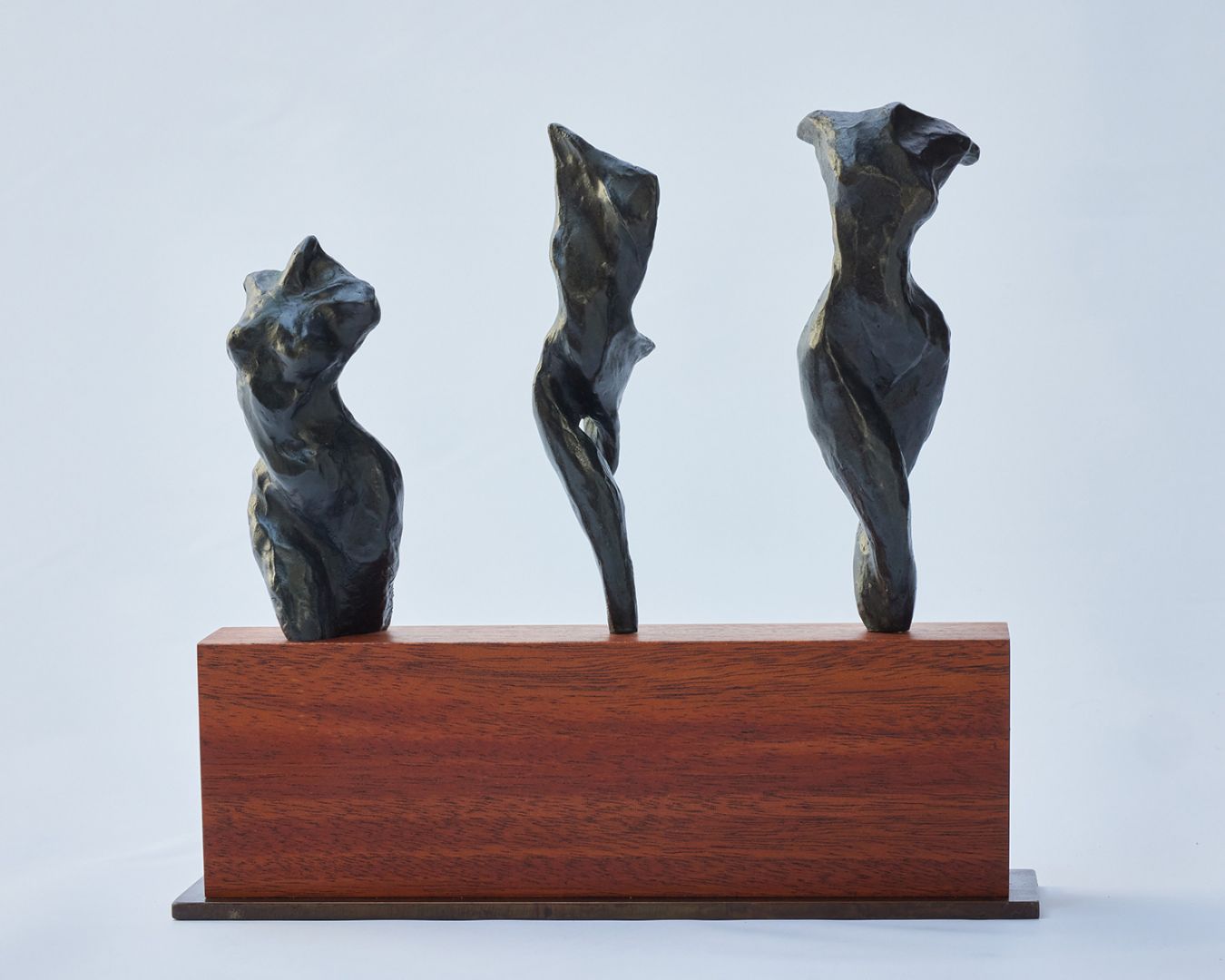
Website: susaneriksonhawkins.com
Instagram: @susanehawkins Susan Erikson Hawkins
Facebook: Susan Erikson Hawkins
Image Credits
Bernie Hawkins ( photo of Susan in studio)
Susan Hawkins (terracotta)
Stephanie Luis (the rest of the photos)
